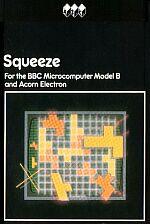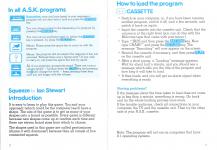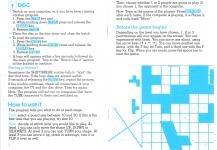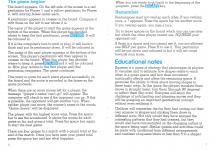


| Genre: | Educational, Ages 4-14 |
| Publisher: | Acornsoft/ASK |
| Cover Art Language: | English |
| Machine Compatibility: | BBC Model B, BBC Model B+, BBC Master 128, Acorn Electron |
| Release: | Professionally released on Cassette |
| Available For: | BBC/Electron |
| Compatible Emulators: | BeebEm (PC (Windows)) PcBBC (PC (MS-DOS)) Model B Emulator (PC (Windows)) Elkulator 1.0 (PC (Windows)) |
| Original Release Date: | 1st January 1984 |
| Original Release Price: | £9.95 |
| Market Valuation: | £11.45 (How Is This Calculated?) |
| Item Weight: | 64g |
| Box Type: | Cardboard Box (Decorative) |
| Author(s): | Ian Stewart |
Variant Items
There are 0 other items featuring this same game (that we know about!). Click any of them for their details.
Active Auctions
Closed Auctions
Buy It
Unfortunately no-one is currently selling this item.
Auction Price Watch
Worried you're being ripped off? Closing prices on eBay can help you decide what a reasonable price is for a particular item.

A&B Computing
1st November 1984
Although it is like board games that I have played previously, this is a good computer implementation and it really adds to the enjoyment. Read Review
Full Instructions
Blurb
Squeeze is a game of strategy which children and adults of all ages will enjoy. You and your opponent each have a shape. The aim of the game is to squeeze your opponent out and to put as many of your shapes onto a board as possible. There are lots of different shapes and board sizes from which to choose and three levels to master.
Planning your moves is challenging and exciting. You are able to go from a simple movement up, down or sideways to one which turns or flips the shapes. Squeeze encourages its players to visualise and to estimate how shapes relate to each other in a given space. While having a lot of fun, you will be improving your geometry and toning up your problem-solving muscles as well!
In All ASK Programs
|
|
Remember: once you have typed in your response a program will deal with it until you press the RETURN key. |
|
|
You can always return to the beginning of a program by pressing the ESCAPE key. |
|
|
You can rub out anything typed in, before the RETURN key is pressed, by using the DELETE key. |

|
Means : Please press the space bar to carry on with the program. |

|
Means : the program did not expect the response it has just received. Perhaps there was a typing error? In any case, to carry on, just press the space bar and try again. |

|
All of our programs incorporate sound. There are various volume levels - holding down the CTRL key and pressing the S will change the level - keep pressing the keys until you are happy with the volume. |
Introduction
It is easy to learn to play this game. You and your opponent (which could be the computer) each have a shape. The aim of the game is to get as many of your shapes onto a board as possible. Every game is different because new shapes come up at random each time and there are eleven board sizes from which to choose.
The shapes used in this game are called pentominoes (rhyme it with dominoes!) because they all consist of five connected squares.
How To Use
The program tells you what to do at each stage.
First: select a board size between 10 and 20. If this is the first time that you are playing, try size 10.
Next: decide at which level you would like to play. At level 1 you can only move the shape up, down or sideways. At level 2 you can also turn your shape. At level 3 you can move it up, down or sideways, turn it or flip it over as well.
Then: choose whether 1 or 2 people are going to play. If you choose 1, the opponent is the computer.
Now: Type in the names of the players. Press RETURN after each name. If the computer is playing, it is Player 2 and calls itself "Micro".
Before The Game Begins
Depending on the level you have chosen, 1, 2 or 3 pentominoes will now appear on the screen. You can experiment with them. You can move one about, using the arrow keys. You can move another one about, with the T key for Turn, and a third one with the F key for Flip. When you are ready, press SPACE to start the game.
How To Play
The board appears. On the left side of the screen is a read pentomino for Player 1 and a yellow pentomino for Player 2, with scoring boxes under each.
A pentomino appears in crosses on the board. Compare it with those on the left to see whose it is.
The name of the player to start the game appears at the bottom of the screen. When this player has decided where to keep the first pentomino, press RETURN. It will be coloured in.
If it is the computer's turn to start or play, it will have a think and put its pentomino down. It will be coloured in.
The name of the next player appears at the bottom of the screen. This player's pentomino will then appear in crosses on the board. When this player has decided where to keep it, press RETURN and it will be coloured in. Now play returns to the first player and that pentomino reappears. The game continues.
One point is given for each piece placed successfully on the board and the score is recorded in the boxes as the game proceeds.
When there are no more moves left for a player, the message "(player's name) can't go" will appear. The computer will check to see if the opponent can go. If this is possible, the opponent will get another turn. When neither player can move, the winner's name or the words "Game drawn" will be displayed.
The player with the highest score wins. Press SPACE to see the scoreboard. It shows the scores for each game so far, and gives a total. Press SPACE again to start the next game.
There are four games to a match with a grand total at the end of the match. Once you have seen your grand total, press SPACE and see what happens...
When you are ready to go back to the beginning of the program, press ESCAPE.
Remember
Pentominoes must not overlap each other. If you overlap once, a ? appears. Press SPACE for another move. If you overlap again, you miss a turn.
Try to leave spaces on the board which you can use later but which the other player cannot use. Squeeze your opponent out!
If there is a space and you cannot see it, you are allowed one HELP per game. Press H to use it. Your pentomino will be put down and coloured in but it will not count towards your score.
Educational Notes
Squeeze is a game of strategy that encourages its players to visualise and to estimate how shapes relate to each other in a given space and how their movement continually affects and alters the remaining space. It promotes the ability to think about moving shapes in three basic ways. In this game the players translate them (move in straight lines)m turn them (through 90 degrees) or reflect them (flip over). Everyone will enjoy the challenge of anticipating and planning moves and they will be grasping an important geometrical concept without even realising it.
Children will remember the fun they had cutting out their own squares or shapes and sticking them down in different ways. Not only would they have enjoyed the interesting patterns that they had created, but they would also have concentrated on the changing nature of the space being used. Similar games and activities could be made with cardboard from different arrangements and numbers of squares (more or less than 5 to a shape).
Screen Designers
The following utilities are also available to allow you to edit the supplied screens of this game:
Cheats
Download
A digital version of this item can be downloaded right here at Everygamegoing (All our downloads are in .zip format).
| Download | What It Contains |
|---|---|
| A digital version of Squeeze suitable for BeebEm (PC (Windows)), PcBBC (PC (MS-DOS)), Model B Emulator (PC (Windows)), Elkulator 1.0 (PC (Windows)) | |
| A digital version of Squeeze suitable for BeebEm (PC (Windows)), PcBBC (PC (MS-DOS)), Model B Emulator (PC (Windows)), Elkulator 1.0 (PC (Windows)) |
Report A Problem
We thank you from the bottom of our hearts if you report something wrong on our site. It's the only way we can fix any problems!
You are not currently logged in so your report will be anonymous.
Add Note
Release Country
Change the country to update it. Click outside of this pop-up to cancel.
Scan Of Selected Article
If you auction an item, it will no longer show in the regular shop section of the site.










